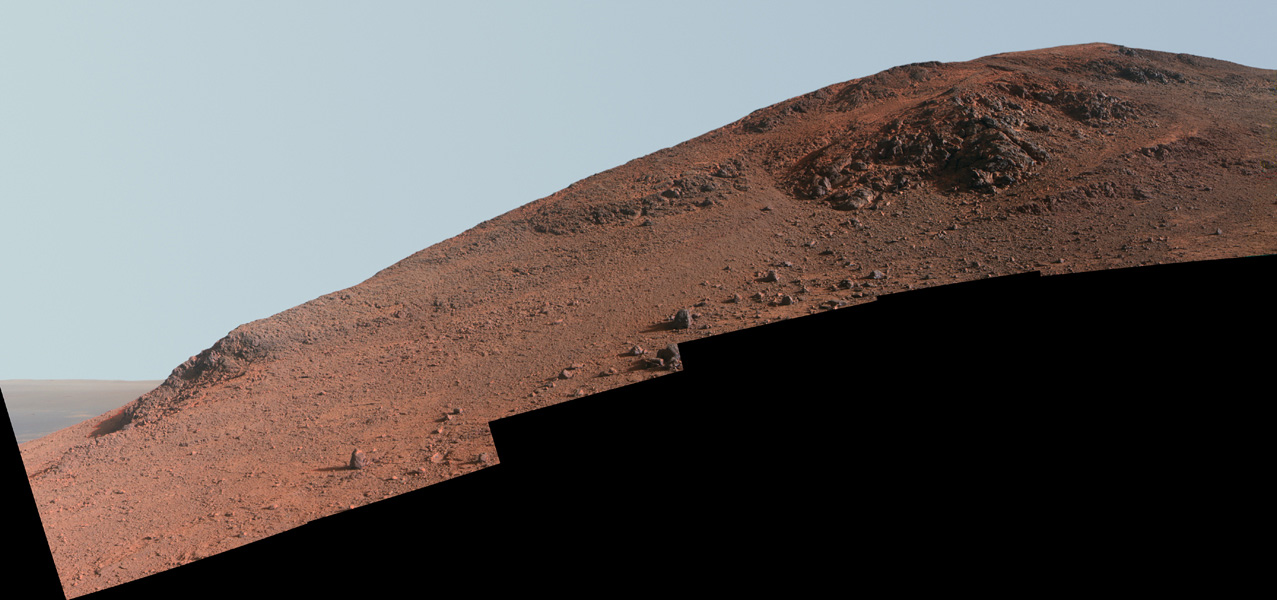Mars Rover Opportunity Climbs Red Planet Ridge (Photo)

NASA's Opportunity Mars rover is tackling some of the toughest terrain the robot has encountered in its twelve years on the Red Planet.
Opportunity began climbing up a 30-degree slope known as Knudsen Ridge late last month, in an effort to reach and study Mars rocks that may have been exposed to liquid water billions of years ago.
The six-wheeled robot has managed very well on the slope — the steepest Opportunity has dealt with since March 2004, just two months after it touched down on the Red Planet, NASA officials said. [Latest Mars Rover Photos from Opportunity]
"Opportunity showed us how sure-footed she still is," rover project manager John Callas, of NASA's Jet Propulsion Laboratory in Pasadena, California, said in a statement. "The wheel slip has been much less than we expected on such steep slopes."
Knudsen Ridge sits atop the southern arm of Marathon Valley (which received its name because it was there that Opportunity's odometer passed 26.2 miles, or 42.2 kilometers — the length of a marathon race here on Earth).
Opportunity's handlers want the robot to examine the crumbly rocks within Knudsen Ridge's "red zones," stretches that stand out from the surrounding tan bedrock. The rover already eyed some red-zone rocks in some of Marathon Valley's lower reaches, but team members want to get a look at "purer exposures" of the stuff.
"We're hoping to take advantage of the steep topography that Mars provides us at Knudsen Ridge to get to a better example of the red-zone material," Opportunity principal investigator Steve Squyres, of Cornell University in Ithaca, New York, said in the same statement.
Breaking space news, the latest updates on rocket launches, skywatching events and more!
Opportunity landed on Mars in January 2004, a few weeks after its twin, Spirit. Both rovers embarked on a hunt for signs of past water activity on the Red Planet — and both quickly found plenty of such evidence.
Many of the rocks examined by Opportunity close to its landing site suggested the area had been exposed to acidic water. But NASA's Mars Reconnaissance Orbiter has spotted signs of clay minerals (a kind of phyllosilicate) in the Marathon Valley region. Phyllosilicates suggest past interaction with more neutral, possibly life-friendly water, researchers said.
"The locations of red zones in Marathon Valley correlate closely with the phyllosilicate signature we see from orbit," Squyres said. "That alone is not a smoking gun. We want to determine what it is about their chemistry that sets them apart and what it could have to do with water."
Spirit and Opportunity were originally tasked with three-month missions, but the golf-cart-size rovers kept rumbling along far past their warranty dates. Spirit stopped communicating with Earth in March 2010 and was declared dead a year later, while Opportunity is still exploring; it has been motoring around the rim of the 14-mile-wide (22 km) Endeavour Crater since August 2011. (Knudsen Ridge lies along the crater's western rim.)
Opportunity has traveled farther on the surface of another world than any other vehicle in history. The rover's odometer currently reads 26.51 miles (42.66 km).
Opportunity is showing some signs of its advanced age. Last year, the rover began experiencing problems with its flash memory — the kind that can store data even when the power is off.
"The only data being received from Opportunity is what can be transmitted each day before the solar-powered rover shuts down for energy-conserving overnight 'sleep,'" NASA officials wrote in the same statement.
Follow Mike Wall on Twitter @michaeldwall and Google+. Follow us @Spacedotcom, Facebook or Google+. Originally published on Space.com.

Michael Wall is a Senior Space Writer with Space.com and joined the team in 2010. He primarily covers exoplanets, spaceflight and military space, but has been known to dabble in the space art beat. His book about the search for alien life, "Out There," was published on Nov. 13, 2018. Before becoming a science writer, Michael worked as a herpetologist and wildlife biologist. He has a Ph.D. in evolutionary biology from the University of Sydney, Australia, a bachelor's degree from the University of Arizona, and a graduate certificate in science writing from the University of California, Santa Cruz. To find out what his latest project is, you can follow Michael on Twitter.
